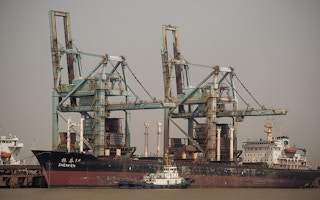Last month, Wuhan Iron and Steel and Shanghai-based Baosteel said they were planning for “strategic restructuring.” If completed, the new behemoth will be the largest steel producer in China with annual output reaching at least 60 million tonnes a year.
The plan was announced as China’s steel industry has suffered heavy losses due to overcapacity amid sagging global demand.
In 2015, more than half of China’s steel companies reported losses totaling 64.53 billion yuan (9.78 billion U.S. dollars), the China Iron and Steel Association estimated.
Wuhan Iron and Steel reported a loss of 7.52 billion yuan. Baosteel’s profits shrank by more than 80 per cent from a year ago to its lowest level in 18 years.
Ma Guoqiang, Board chairman of Wuhan Iron and Steel, said restructuring is a must if China wants to cut excess steel capacity, improve efficiency and create globally competitive firms.
The steel sector was once a profit engine for China’s economy as the infrastructure investment boom bolstered demand for commodities such as steel and cement.
As the economy cools, the production glut has been exacerbated.
Li Jin, deputy head of the China Enterprise Reform and Development Society, observed the restructuring will cut excess capacity of the two steel companies, and encourage them to use their complementary advantages to improve overall competitiveness.
The restructuring plan also marks a key part of the country’s SOE reform, as the government has identified it as an essential step in the structural transformation of China’s economy.
Over the last three decades, SOEs have underpinned China’s emergence as a global manufacturing powerhouse and came to dominate key strategic sectors.
However, the traditional single-sided markets are now being disrupted by new technology firms and private companies, which has underlined the weaknesses of SOEs, such as inefficiency and high operational costs.
Chinese authorities unveiled a new chapter of SOE reform early this year, putting the focus of reform on mega-mergers of state groups in order to boost competitiveness through economies of scale.
After approval by the State Council, China International Travel Service Group Corporation is now a wholly owned subsidiary of the China National Travel Service (HK) Group Corporation.
The country has seen a mega-merger between its two largest train makers, CNR Corp. Ltd. and CSR Corp. Ltd. The government has also approved a merger between China Metallurgical Group and China Minmetals Corporation, both of which are Fortune 500 companies, and created the world’s fourth-largest container shipper through the merger of China Ocean Shipping Group and China Shipping (Group) Company.
However, mega-mergers do not necessarily lead to good restructuring, Ma Guoqiang said, adding that realignment without true restructuring would not sort out the overcapacity problem.
Li Jin observed the size, complexity, and organisational culture of SOEs will also complicate implementation of reform.

















